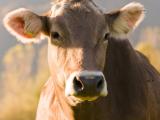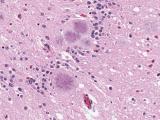Feb 14, 2005 (CIDRAP News) The investigation of Canada's third case of bovine spongiform encephalopathy (BSE), or mad cow disease, suggests that the cow ate feed contaminated with banned materials, according to the Canadian Food Inspection Agency (CFIA).
The cow was born in March 1998, a few months after Canada banned the use of cattle protein in feed for cattle and other ruminant animals in 1997, the CFIA said in reporting the results of its investigation. Cattle can contract the disease by eating protein from infected animals.
"This investigation identified that certain feed materials, likely manufactured a short time after the implementation of Canada's feed ban, may have been contaminated," the agency said. The investigation revealed no more cases of BSE in cattle linked with the infected cow.
The BSE case was confirmed on Jan 11, just 9 days after confirmation of Canada's second case. Contaminated feed is suspected as the cause of the second case as well, but that cow was born in 1996, before the feed ban was imposed.
Investigators found that the infected animal, a Charolais beef cow, was exposed to four commercial feeds in its early years. Officials couldn't determine exactly when the feeds were made, but it was probably shortly after the feed ban took effect.
"Although these four feed sources should not have contained ruminant meat and bone meal (MBM), the possibility that one or more of them may have been contaminated cannot be ruled out," the CFIA said. "The feed manufacturers were handling ruminant MBM for the manufacture of non-ruminant feeds during the time-frame of interest."
The agency said the finding "is consistent with the experience of all countries with BSE which have implemented feed bans." Because of the complexity of the required changes in feed mills, some cattle feed produced shortly after the feed ban might have been contaminated with banned materials, officials said.
Investigators determined that there were 349 cattle in the infected cow's birth cohortcattle born on the same Alberta farm within 12 months before or after the cow. Forty-one of these turned out to be still alive; they were killed, tested, and found to be free of BSE. The carcasses were incinerated.
Of the other 308 cattle, the investigation showed that 32 had died on the original farm, 273 were dead or had been slaughtered in Canada, and three could not be traced, the CFIA said.
The statement acknowledged that some cattle from the birth cohort probably were slaughtered before Canada banned specified-risk materials (SRMs) from human food. SRMs are tissues such as the brain, spinal cord, eyes, and tonsils, which are likely to contain infectivity if a cow has the disease.
But the agency said meat from those cattle probably posed very little risk. Among other reasons, most beef cattle in Canada are slaughtered at an age between 18 and 22 months, making them unlikely to have infective levels of disease, officials said. BSE has very rarely been found in cattle less than 30 months old.
Given the low number of BSE cases in Canada and the time it took for the disease to show up after the feed ban, the CFIA said, "There is a strong basis to believe that the feed ban, as designed and delivered, is doing its job."
In July 2004 the CFIA proposed to ban the use of SRMs in all animal feed and pet food as a further BSE safeguard. Last week the agency said the deadline for commenting on that proposal is Feb 24. The aim of the proposal is to prevent cross-contamination, which can happen if SRMs in pig or poultry feed end up in cattle feed made in the same mill or if cattle are given feed intended for nonruminants.
The US Food and Drug Administration has talked about a similar ban on SRMs in all animal feeds but has not formally proposed one.

















